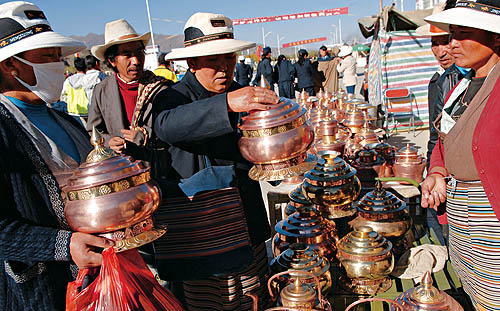|

In 2006, taking full advantage of the historical chance of the opening of the Qinghai-Tibet Railway, Tibet worked to further normalize market order, which promoted the constant increase of consumption demand concerning tourism, vehicles, housing, catering and recreation. The retail sales of consumer goods reached 8.970 billion Yuan, an increase of 22.7 percent, the biggest increase in the new century. This broke down into 4.380 billion Yuan of sales in urban areas, an increase of 32.7 percent; 4.591 billion Yuan of sales in counties and places below the county level, an increase of 14.5 percent. A total of 7.161 billion Yuan came from wholesale and retail trade, an increase of 21.0 percent; 1.576 billion Yuan from restaurant and catering business, an increase of 27.3 percent; 234 million Yuan from other businesses, an increase of 53.2 percent.
Retail sales of garments, hats, shoes and knitwear rose by 33 percent; that of oil and oil products rose by 17.3 percent; that of automobiles rose by 72.9 percent; that of bullion and jewelry increased by 24.0 percent; and that of home appliances and video and audio electronic equipment increased by 14.6 percent.
The total consumption price level of residents in Tibet rose by two percent over 2005. That of the urban area rose by 1.9 percent and that of rural areas was up 2.4 percent; service income rose by 5 percent; and that of consumer goods by 1.5 percent. Among the different kinds of consumer goods, that of the recreation, education and culture articles and services, transport and communication, residential fees and food rose 4.8, 4, 3.6 and 2.9 percent respectively. The retail prices of consumer goods rose by 0.2 percent and the price of agricultural means of production rose 0.4 percent; the purchasing price of agricultural products increased by 3.3 percent and the cost price of industrial products rose by 6 percent.
Tibet actively encouraged and supported the development of modern circulation styles such as chain operation, distribution and franchise management and the new-type circulation businesses such as supermarkets, convenience stores and special small shops. By the end of 2006, there were all together 1,743 chain shops, supermarkets and convenience stores. |
